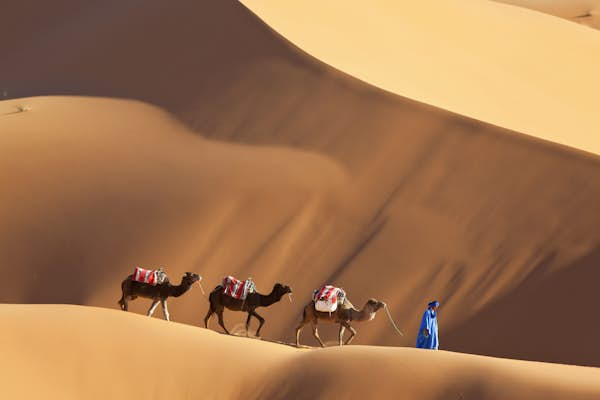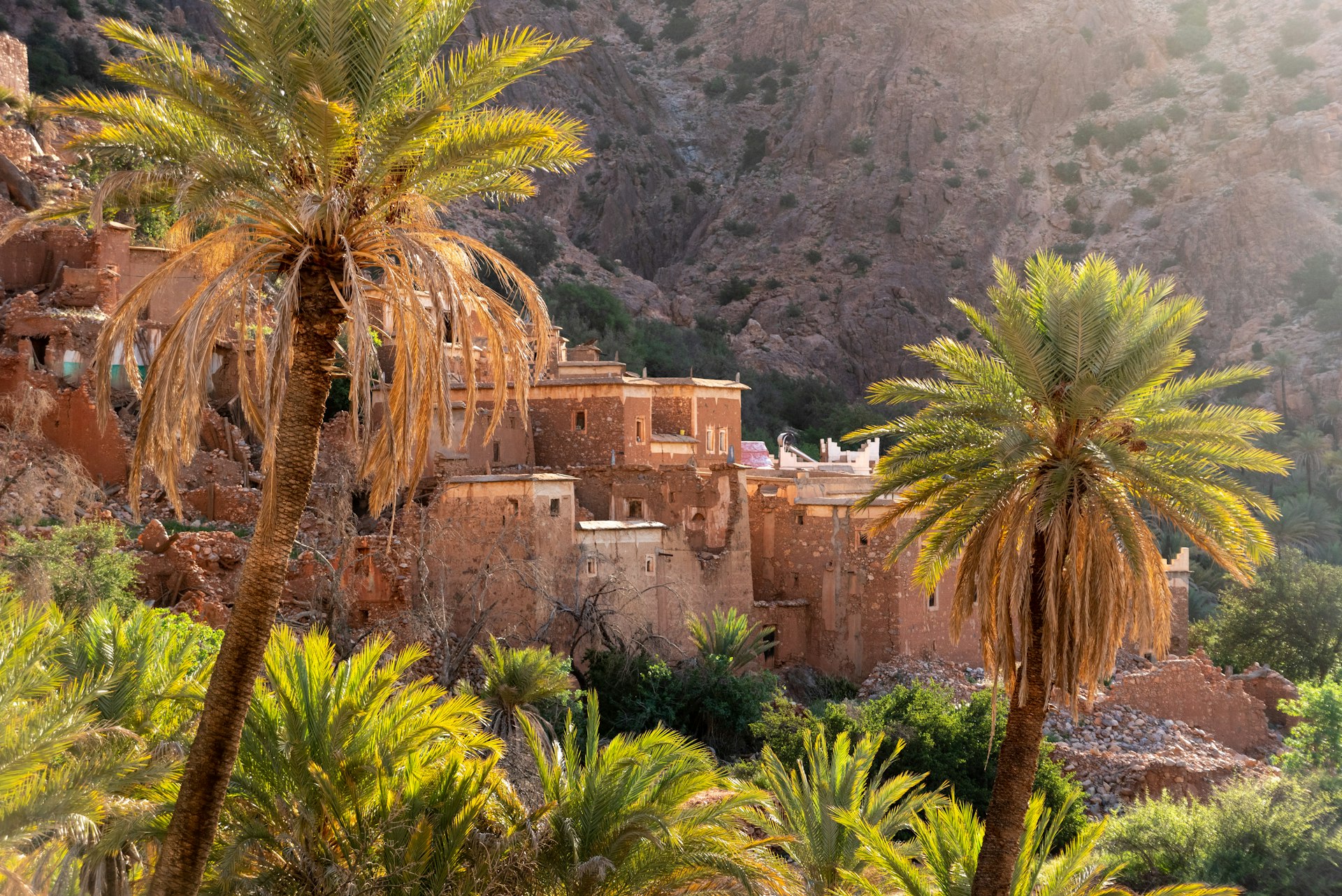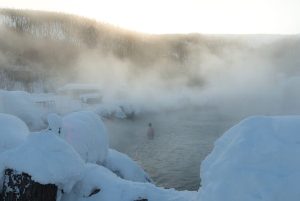
Morocco is a fantastic year-round vacation destination, but choosing the best time of year to travel will depend on your interests and holiday needs.
The mild months from October to April see an influx of travelers from the northern hemisphere, flocking to North Africa to escape long winters in Europe or North America. For the rest of the year, Morocco is busy with domestic travelers, especially along the coast in July and August, and international travelers taking advantage of package holiday deals and outdoor activities such as surfing, kiteboarding, golf, music and hiking.
Whether you come for the sun, the surf, the wind sports, the outdoors, local festivals or the rich culture, here’s a guide to the best times to travel to Morocco.
Editor’s note: On September 8, 2023, a 6.8 magnitude earthquake struck central Morocco, centered on the Atlas Mountains and the area southwest of Marrakesh. Travel to other parts of the country, including Fez, is largely unaffected, but we encourage travelers to check bulletins and monitor reliable local news sources for the latest information.
 The end of summer is a great time to see the sights in Morocco © Adam Smigielski / Getty Images
The end of summer is a great time to see the sights in Morocco © Adam Smigielski / Getty Images
September is the best month for weather and fewer crowds
Domestic and international travelers head back to school and work after the August summer holidays, so September is a great time to visit. The weather is still warm, with long sunny days, balmy waters and quiet beaches. It’s also an excellent time to visit cultural sights in coastal cities such as Essaouira, Rabat, Casablanca, Tetouan, and Tangier. Inland, Marrakesh and surrounding regions can still be quite hot in September.
Spring and fall are the best times to visit the Sahara Desert
During May and October, you can travel comfortably to Morocco’s portion of the Sahara Desert, avoiding the intense heat of summer and the cold nights of winter. If you come in summer, expect to find most desert camps closed from June to August due to the excessive heat, which soars over 100°F. Conversely, days are shorter during the winter months from December to February and the nights and early mornings can be freezing, particularly when sleeping under canvas.
Springtime is beautiful, with a green blanket of wild rocket on the sand and the birthing of baby camels. Sandstorms occur from January to May, but Saharwians are used to these storms; follow their lead by wearing a Tuareg scarf to protect your face from the sand and sun.
 Spring and fall are prime times to explore the High Altas mountains © Roberto Moiola / Sysaworld / Getty Images
Spring and fall are prime times to explore the High Altas mountains © Roberto Moiola / Sysaworld / Getty Images
Spring and fall are also great times to hike in the High Atlas Mountains
The right time for the Atlas Mountains depends on your fitness levels and how much of a challenge you are up for. The High Atlas region is a year-round hiking destination, but the weather is mildest from April to June and September to November, creating ideal trekking conditions for all fitness levels. If you visit in May, you’ll see the M’Goun Valley come alive for the Festival des Roses.
Come prepared for the seasons. If you climb Mount Toubkal from November to June, you may need snowshoes and you’ll be camping in freezing temperatures. From July to October, the snow melts, and the altitude provides a welcome escape from the summer heat of other regions in Morocco.
December to February is the season for skiing in Morocco
In deep winter, the peaks of the High Atlas are covered in snow – perfect for those who prefer to ski down rather than hike up mountains. The snow can create hazardous conditions for driving on remote roads, and some routes will close, but the main skiing areas – Oukaimeden and Ifrane – are accessible and skiing will be a fun addition to your North African adventure.
 Explore the Anti-Atlas range in peaceful solitude in spring © imagoDens / Getty Images
Explore the Anti-Atlas range in peaceful solitude in spring © imagoDens / Getty Images
Enjoy Anti-Atlas hikes and blossom-filled valleys from February to April
If you prefer to trek at lower altitudes and steer clear of snowy peaks, consider a visit to the Anti-Atlas mountain range. This season is for wildflowers, spring blossoms in the trees and quiet hiking trails. An annual almond blossom festival takes place in Tafraoute in February or March, depending on when the trees flower and the harvest.
June to September are the best months for music events and festivals
Morocco’s long summer days and nights are ideal for outdoor music events, as bands and musicians fill venues nationwide. Top festivals to look out for include the Fez Festival of World Sacred Music (dates vary from June to September), Essaouira’s Gnaoua World Music Festival in June, the Asilah Festival in July and October and Casablanca’s Jazzablanca in June.
Rabat’s Mawazine – said to be the world’s largest festival – is set to return in 2024 after a three-year gap. To find accommodation close to venues, book well in advance and be prepared for higher prices.
 A surfer on the beach at sunset in Taghazout © mgs / Getty Images
A surfer on the beach at sunset in Taghazout © mgs / Getty Images
The best time for surfing is October to March
Winter is when the Atlantic swell is most consistent on the Moroccan coast. December to February see the largest waves, and surfers flock to Taghazout, Mirleft, Sidi Ifni and other spots along Morocco’s west coast. A lively center for surf culture, Taghazout hosts an annual surf expo in October and international competitions such as the World Surf League in January and February.
If you prefer to surf in warmer, more mellow waves, travel from June to November, when conditions are ideal for beginners and intermediate surfers. May can sometimes be windy with the change of season, but this is usually just in the afternoons, so you can still catch some waves in the morning.
April to September is the best time for kitesurfing and wind sports
This season brings reliable high winds thanks to the thermal effect along the Moroccan coastline, but kitesurfing and windsurfing are possible year-round due to consistent trade winds from the Atlantic and several flat water spots in Essaouira and Dakhla. An annual international kitesurfing competition is held in Dakhla at the end of September, drawing competitors and spectators from around the world.
 Avoid the hot summer and cool winter to make the most of Marrakesh © Thomas Barwick / Getty Images
Avoid the hot summer and cool winter to make the most of Marrakesh © Thomas Barwick / Getty Images
September to November and March to May are the best times to visit Marrakesh
For sunny days and not too hot or cold temperatures, visit Marrakesh in spring or fall. Avoid June to August unless you have a love affair with air conditioning and 100°F heat. Nights can be cold from December to February, especially in riads (courtyard homes) without central heating, but outside of the Christmas festive season, winter is a quiet time for city exploration, with the majestic, snow-covered Atlas Mountains as a dramatic backdrop.
July and August in Morocco are best spent on the coast
On the Atlantic coast, cooling breezes and misty fog keep summer temperatures down to around 80°F, while inland, temperatures can soar to well over 100°F. Agadir, Dakhla and Essaouira are particularly popular with domestic travelers in August thanks to the long sunny days and lifeguard-protected beaches.
While the Moroccan sun is strong, beach parasols and covered outdoor seating are easy to find, and the ocean is calmer and warmer – perfect for swimming, riding pedalos, stand-up paddleboarding and surfing for beginners. Try to pick accommodation within walking distance of the beach to avoid sitting in August traffic queues.
Christmas and New Year is best for celebrations and parties
In Marrakesh and other hubs popular with foreign residents and visiting travelers, you can enjoy epic celebrations over the festive season. However, accommodation prices increase significantly over the peak vacation dates from 22 December until 7 January. Yennayer, the Amazigh New Year, falls in the first week of January, so there may be some local festivities around at this time as well.
 A stork flies over the historic Chellah Necropolis in Rabat © Andrea Pistolesi / Getty Images
A stork flies over the historic Chellah Necropolis in Rabat © Andrea Pistolesi / Getty Images
Spring and fall are the best seasons for birdwatching in Morocco
The mild spring and fall are the times to see migratory birds traveling to and from Africa and Europe at various sites across the country. The top birding spot on the coast is Oualidia; its peaceful lagoon is a haven for resident and migratory waterbird species. The High Atlas region has plenty of idyllic places to watch migrating birds as they pass through, including the Lake Takerkoust area and the Ourika Valley. Souss-Massa National Park also attracts migratory birds, which gather here in large numbers on arrival from, and before departing for, their Atlantic crossings.
Come during winter or Ramadan to experience Morocco without the crowds
The weather can be cold and wet from December to February, especially in the north, but winter is an excellent time for city and cultural explorations without the crowds. Also, check the dates for Ramadan, the Muslim month of fasting; these change each year. This important annual festival is a quiet and spiritual time to experience Morocco; many food establishments close during the day but places to eat at hotels still operate.



